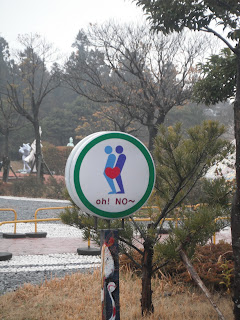 |
| A row of Cherry blossoms in full bloom. According to my host father, (who heard it on the news) 2 million people visited the festival over the weekend. |
War and Peace
After visiting the Cherry Blossom Festival, we decided to visit the Korean War Memorial, a museum that chronicles the military history of the peninsula.
 | ||
| The War Memorial of Korea serves as a physical document to the military history of the nation, a memorial for those who served, and a glimpse into the future of the Korean armed forces. |
Since the cease-fire that ended the Korean War in 1953, South Korea enacted a mandatory military conscription for all males. Fearing an imminent threat from the north, a large standing army has been mobilized ever since. In this context, the glorification of the Republic of Korea's armed forces makes a little more sense-if every male must enlist, The Korean War museum serves as much as a somber memorial as it does as a tool for enlistment.
Although the military hardware was pretty cool to look at, the most fascinating part of the museum by far was way in which certain information was presented. Given its importance in peninsular history, The Korean War was presented in great detail. Fascinatingly enough, while I was walking through the exhibit, I was joined by a number of US Army servicemen who are stationed here in South Korea. Although the war has been over for almost 60 years, the mere presence of 29,000 US servicemen in the country speaks to the lasting effects of the war. Sadly, the armistice agreement of 1953 achieved nothing but a divided nation at the cost of 3 million lives.
The museum moves chronologically through South Korea's armed conflicts during the 20th century. When walking through the Vietnam War Exhibit, one placard in particular caught my attention. Since South Korea was indebted to the United States following the Korean War, they have assisted in every US foreign policy action during the second half of the 20th century. Along with the 2.7 million Americans who served in the Vietnam War in some capacity, South Korea sent an additional 313,000 troops. Yet the museums portrayal of the conflict was quite fascinating:







